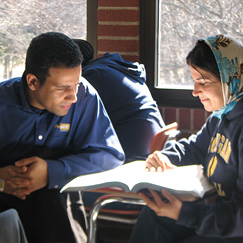Introduction to Our Plural History
Richard Norman, Ph.D.We have all heard that the United States is "a nation of immigrants," a "melting pot" or a "tossed salad," but what do these terms tell us about the evolution of U.S. society, cultural change, and the development of an "American" national identity?
This website will examine the idea of pluralism in the United States by focusing on immigrant and ethnic groups in the Connecticut River Valley of western Massachusetts. Our purpose here is to show the contributions made to American society by different cultural groups, the richness of American lives in ethnic, racial, religious and cultural terms, and to increase understanding of the unique and shared experiences of all Americans.
The project began with a consideration of the meaning of pluralism [PDF] . "Our Plural History" recognizes that U.S. society is constituted by disparate ethnic, racial, religious, linguistic, and cultural groups. So, in a basic sense, pluralism refers to a complex of values, beliefs, behaviors, customs and social forms that cannot be reduced to one. Pluralism implies something beyond simple variety, however. For American society, diversity is a given, but pluralism is a learned practice. Beyond the mere tolerance of difference, the practice of pluralism requires the active development of understanding across lines of difference — to purposefully set out to learn about others different from ourselves in order to overcome ignorance, stereotypes and the fears that underlie old patterns of division. Pluralism requires us to engage in a process of discovery and conversation that reveals both common understanding and real differences. We do not have to agree with each other, but we have to agree to live together.
Our objective then is to account for the diversity of life in the United States and to describe the often difficult development of pluralism as a social practice. The Connecticut River Valley of western Massachusetts provides an ideal laboratory for revealing the diversity of U.S. society in ethnic, racial, religious and cultural terms. As a waterway and natural resource, the Connecticut River was vital to the lives of the indigenous people and European colonists. Springfield was a key destination on the Underground Railroad and for African Americans fleeing the Jim Crow South during the Great Migration. Industrialization in the cities of Springfield, Chicopee and Holyoke attracted migrants and immigrants alike. Springfield and the Connecticut River Valley continue today to attract immigrants from around the world.
In revealing the experiences of ethnic communities in the Valley — their arrivals, their interactions with other groups, and their responses to social, economic and political changes in the U.S. — the website touches upon the full range of beliefs, behaviors and customs that constitute culture. For people everywhere, culture imparts a sense of identity and community. The idea of culture encompasses everything from routine activities involving food and dress, family life and traditions surrounding birth, marriage and death to gender relations, forms of political organization, spirituality, work and commerce, music and literature.
By revealing the rich variety that has marked life in Springfield and the Connecticut River Valley, we hope to bring into focus the meaning of American pluralism and to explore the related concept of multiculturalism. The coexistence of many different cultural communities in the United States is heralded by some as a triumph for tolerance and an illustration of American exceptionalism. Our diversity is our strength. Others argue that the preservation and promotion of ethnic and cultural differences weakens the bonds that hold a nation together. What is "American"? The history of cultural communities in the Connecticut River Valley of western Massachusetts — "Our Plural History" — shows that the answer to that question is not simple.
